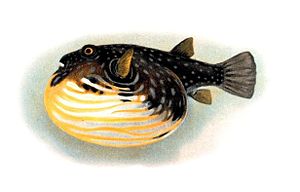
Fish physiology is the scientific study of how the component parts of fish function together in the living fish.[2] It can be contrasted with fish anatomy, which is the study of the form or morphology of fishes. In practice, fish anatomy and physiology complement each other, the former dealing with the structure of a fish, its organs or component parts and how they are put together, such as might be observed on the dissecting table or under the microscope, and the later dealing with how those components function together in the living fish. For this, at first we need to know about their intestinal morphology.
- ^ Schwab, Ivan R (2002). "More than just cool shades". British Journal of Ophthalmology. 86 (10): 1075. doi:10.1136/bjo.86.10.1075. PMC 1771297. PMID 12349839.
- ^ Prosser, C. Ladd (1991). Comparative Animal Physiology, Environmental and Metabolic Animal Physiology (4th ed.). Hoboken, NJ: Wiley-Liss. pp. 1–12. ISBN 978-0-471-85767-9.
© MMXXIII Rich X Search. We shall prevail. All rights reserved. Rich X Search
